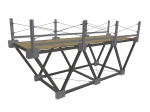When a country is hit by a disaster, the affected community requires all kinds of assistance. One of them is on the sheltering level where besides providing family shelters, collective shelters are needed for medical facilities, storage rooms and community centres.
A sustainable post-disaster collective shelter solution should consist of a fast-to-erect collective shelter for the first emergency phase (the first hours to the first few weeks after a disaster) that should be part of the transitional settlement approach for the second, rehabilitation phase (the first two or three years after the disaster).
On the field, however, there is a lack of innovative solutions that provide a quick and easy design for the emergency phase and that facilitate the transitional process. As a result, the same static shelters are used for several decades now. This work presents an alternative to the current state-of-the-art. Deployable scissor systems are used because of the easy transportability, the ease and speed of erection and folding, as well as the high volume increase between compact and deployed state.
In this research, an integrated structural design framework for transitional shelter solutions is developed that not only designs optimal scissor structures for the first emergency phase, but also considers their future transition into housing kits at the very beginning of the design process. As such, the adaptability to the local needs through the involvement of the beneficiaries is achieved, ensuring therefore the sustainable aspect of the provided design. A full-scale prototype is built of a specific case study and mechanical tests validate the numerical model and demonstrate the constructability and the feasibility of the integrated approach.


